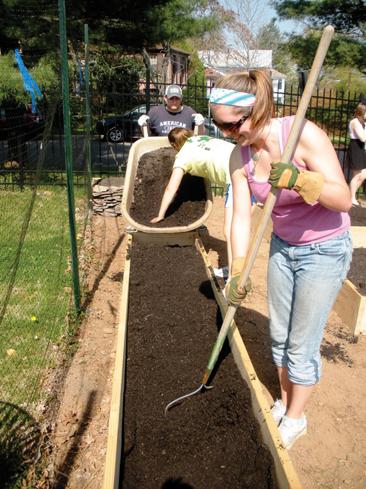As citizens around the globe continue to put efforts into preserving the environment, individuals living and working on college campuses are among the leaders of the pack. With energetic and invested students and supportive faculty, many campuses in the D.C area are paving the way for future environmentalists by making their campuses green. The Georgetowner took a look at the environmental efforts at three local universities — Georgetown, American, and George Washington — and compared just how green these well known campuses are. From recycling to transportation, food to solar energy, we found that each of these three schools thrives in some area of environmental preservation.
Georgetown University
—
Green: Recycling
Not So Green: Long Shuttle Routes
Georgetown University’s budding recycling program is what makes its green efforts unique. Ever since Recycling Manager Bill Del Vecchio took over the recycling department three years ago, the University’s recycling program has grown immensely.
Along with the help of Georgetown’s student environmental advocacy club Eco-Action, Del Vecchio established a recycling outreach program and tracked which areas of campus were most populated to ensure that additional receptacles were placed there. (All the receptacles look the same and are therefore easy to identify.) It appears to be paying off — the recycling rate at Georgetown rose from 12 percent in 2007 to 45 percent in 2010.
Cardboard, plastic, batteries and electronics are only a few of the items that Del Vecchio says are recycled.
“Since I’ve been at school, our recycling program has expanded and developed beautifully,” Eco-Action president Kristin Ng says. “When I started here, we had to sort out all of our plastics and only certain things could be recycled. Now, after a huge renovation of the system, it’s super easy to recycle anything on campus.”
Georgetown received a large grant for recycling in the fall of 2009, at which point the university replaced many of its outside bins with Big Belly Trash Compactors. These solar powered trash compactors are attached to two recycling bins, making recycling a convenient and prevalent option around campus. Recycling bins can also be found in all faculty member offices, and next year the University will place bins in the rooms of all on-campus residence halls and apartments, says former Eco-Action treasurer Jonathan Cohn.
In addition to day-to-day recycling, the University encourages students to preserve their unwanted items through its annual move-out drive. This event allows students to donate items around their dorm rooms that would have otherwise thrown out.
As a result of the University’s efforts, Georgetown moved up in this year’s Recyclemania, a competition that measures colleges recycling rates over a 10-week period. Georgetown ranked 37 out of 267 colleges and universities in the grand champion category. Though technology has been helpful in improving recycling at Georgetown, Del Vecchio says that student and faculty support is what makes the program top notch.
“Faculty, staff, and students all participate in recycling and understand the importance of environmentally sound practices on campus,” he says.
Beyond recycling, the University has also made strides in improving sustainability through the installation of energy monitors in every residence hall. These monitors allow students and faculty to see how much energy their hall is using at any given point. The university also built a LEED Silver-certified business school building in the fall of 2009.
Despite its many green initiatives, Georgetown still has work to do towards improving sustainability, particularly for campus vehicles. Former Eco-Action member Carter Lavin notes, for instance, that the shuttle bus route to the Dupont Circle Metro stop is unnecessarily long. Because West Georgetown residents complained about the busses constantly passing through the neighborhood and shaking their door frames, all University buses going to Dupont Circle during off-peak hours leave from Reservoir Road and take a left on Wisconsin, which, Lavin says, prolongs the route substantially.
—
American University
—
Green: Transportation
Not So Green: Lack of compost system for food
Amid the lists and descriptions on American University’s sustainability Web site lies an overarching slogan declaring that “The American Dream is Green.” Thanks to both the University’s active environmental club Eco Sense and its sustainability department, AU’s green initiatives are continuously expanding. The Sustainable Endowments Institute acknowledged AU’s achievements when they gave the University an “A” for environmentally friendly transportation on its 2010 green report card.
AU’s green transportation policies significantly help lessen fuel consumption on and around campus, according to former Eco Sense treasurer Stephen Bronskill. A complimentary shuttle service takes students to and from the nearest Metro stop.
“The shuttle is used for the vast majority of students commuting into D.C.,” Bronskill says.
AU Sustainability Director Chris O’Brien notes that the University provides several incentives for students and staff to use public transportation, such as payroll deductions for employees who take Metro.
“Use of the free campus shuttle has doubled in the past 10 years, showing that more and more people are choosing to take Metro and then our free shuttle to campus rather than drive personal vehicles.” O’Brien says.
If traveling by train isn’t an option, students and staff can turn to the on-campus Zipcar service, which enables students to rent a car for specific time slots rather than purchasing and bringing their own car to school, making for fewer cars polluting D.C. streets. In a further effort to keep cars off the road, AU offers a condensed work week option for staff members and 10 complimentary bikes for students to rent.
“We have a very impressive and innovative bike lending program that allows students to rent bikes for the day,” Bronskill says. “The plan is so successful that there are plans to double it in size.”
But AU’s green ambitions extend far beyond environmentally friendly transportation options. The University’s Climate Action plan lays out four basic strategies that will help the University to become carbon neutral by 2020.
Eco Sense President Jennifer Jones also notes that Bon Appetit, the company that supplies the food at AU, frequently uses locally grown organic food and that students run a community garden. Still, she says, there are steps the University could take to become more sustainable, including initiating a compost program for pre- and post-consumer food scraps. Though Jones knows that students and faculty still have work to do in terms of improving green practices, she says she is confident in what the future holds for AU in terms of sustainability.
“There is always room for improvement, especially because environmental information is progressing so quickly,” she says. “But between the Department of Sustainability and Eco-Sense, there are a lot of people at AU trying to make us more sustainable.”
—
George Washington University
—
Green: Food
Not So Green: Lack of alternate energy sources
For those looking for an environmentally friendly lunch spot, the George Washington University’s dining hall may be the perfect location. The University, which recently received an “A” for environmentally friendly food on their 2010 green report card, strives to serve locally grown, organic foods whenever possible and works to ensure that dining hall products don’t produce excess pollution.
The fact that GW spends 160,000 annually on locally grown foods such as apples, tomatoes and onions indicates that purchasing these foods is a major priority. The University’s organic purchases are also plentiful, with a total of 250,000 worth of organic foods bought and served yearly.
But GW doesn’t just buy locally grown foods, they also compost them. The University currently composts all pre-consumer food scraps on the Mount Vernon Campus, and will strive to begin post composting next year, according to Sophie Waksow, the stakeholder engagement coordinator with the Office of Sustainability.
In an effort to alleviate pollution caused by excess petroleum, the University has decided to place biodegradable plates in certain campus dining halls. The switch, Green GW President Justin Fink notes, was initiated by a group of students and faculty, and is expected to eliminate close to 600 pounds of petroleum-based serviceware from campus.
“On campus, our dining services have been become increasingly more environmentally conscious over the years,” Fink said. “This past year, leaders of environmental student organizations and administrators have collaborated with Sodexo, our main food provider, to put in place a program to use biodegradable plates and hopefully flatware as well.”
In addition to its green dining options, GW’s buildings are also very environmentally friendly. In September 2009, GW opened South Hall, the first LEED Gold-certified University building in D.C. history. Among its many green attributes are walls with high insulation and bamboo paneling as opposed to hardwood floors, GW Today reported.
Student involvement in environmental initiatives is no rarity at GW. There are a total of 12 student environmental groups on campus, many of which have individual Web sites. Though Fink points out at that the university should improve its green efforts by introducing alternate energy sources like solar energy or biodiesel on campus, Waksow says that students’ continued commitment to environmental preservation indicates just how energized the GW student body is as a whole.
“While universities have a relatively small physical footprint, we have a large impact on the current dialogue and the next generation of leaders,” she says. “GW has a culture of political and civic engagement: our students exercise their leadership skills in sustainability through their activities outside the classroom and in their careers.”
- Josh, Julie, Kate at AU | Nora Birch






